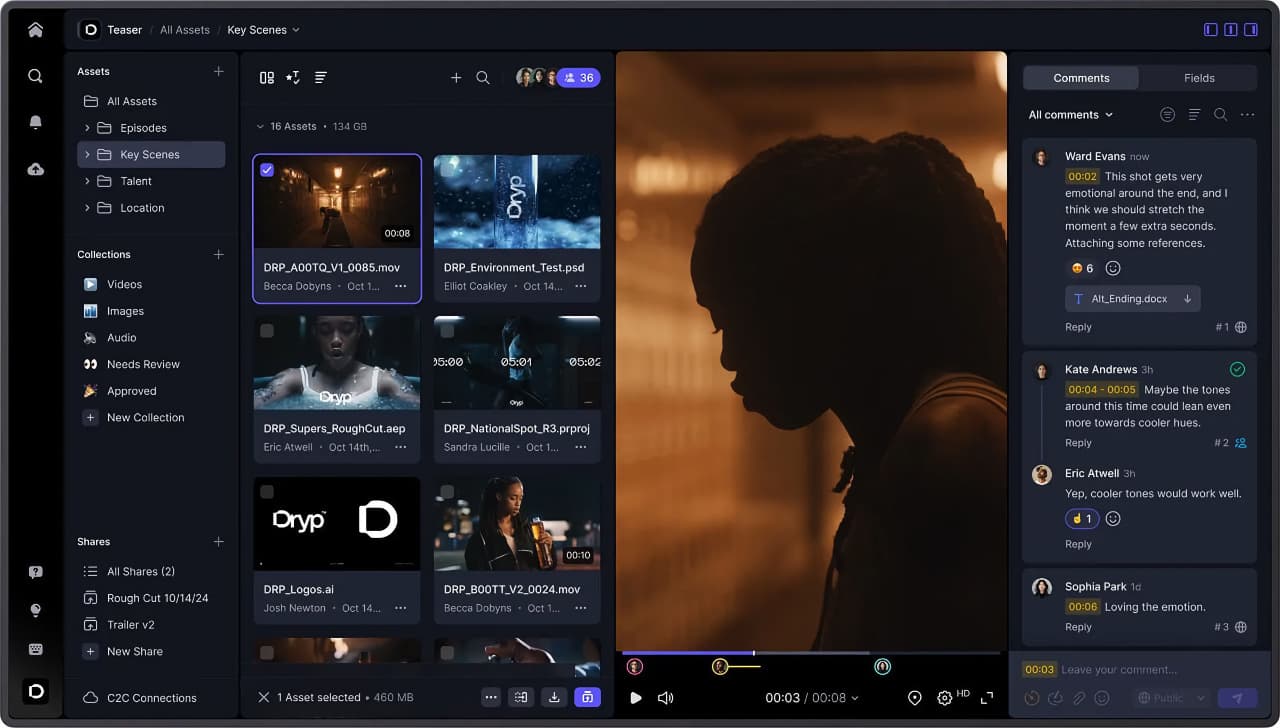
An Adobe MAX one-on-one discussion about Frame.io Version 4 with JJ Powell, Sr. Product Marketing Manager for Frame.io.
As of Adobe MAX 2024, Frame.io Version 4 is now fully released. No more beta, this is this is the real deal. Introducing new features and integrations designed to enhance creative workflows, V4 represented a from-the-ground-up approach by the frame.io team.
I sat down with JJ Powell, Sr. Product Marketing Manager for Frame.io, at Adobe MAX to discuss these developments and what they mean for creatives across the industry. Here are the key takeaways.

1. Out of beta and packed with new features
Frame.io Version 4 is now out of beta and available across all Frame.io plans, including Free, Pro, Teams, and Enterprise.
“Frame.io Version 4, which released in beta at NAB earlier this year, has been built from the ground up, pixel for pixel, to be more performant, customizable, and feature-rich for the modern creative team,” says Powell. “Whether you’re doing photo, video, design reviews—all in Frame.io—it’s now one central location for creatives, collaborators, stakeholders, and all of those assets in one spot.”
“We have high-quality, frame-accurate scrubbing over the actual player,” he notes. “I can leave anchored comments, I can leave attachments as part of these comments—all to say, this is even more contextualization of the comments that you’re leaving in Frame.io beyond what was available previously.”
2. Streamlining creative workflows
A headline feature in Version 4 is the introduction of customizable metadata and Collections, allowing for greater organization and context.
“We also have customizable metadata within Frame.io now,” Powell says. “This customizable metadata is a brand-new way to work in Frame.io. Previously, we just had status—does this need approval? Is this asset complete? Now, we pre-bake a ton of metadata out of the box for you to choose from, but you also have total customization of this metadata to create new fields.”
These metadata fields can be tailored to fit specific project needs, such as adding star ratings or tagging delivery platforms.
“If I wanted to add a star rating to a clip to really gauge how quality is this asset—as opposed to just a status—I can do that. Maybe I want to tag what delivery platform I would put this out if it was for a social media asset.”
This enhanced metadata feeds into Collections—smart folders that automatically organize assets based on filters and groups.
“Collections are smart folders within Frame.io that are based on the filtered and grouped metadata,” Powell says. “Maybe I only want to see five-star assets in Frame.io—I can create a Collection that filters only for five-star assets. It’s all about customization and context, providing a new creative management platform for Frame.io and Adobe.”
3. Expanding camera to cloud partnerships with Canon, Leica, and Nikon
Frame.io announced new Camera to Cloud partners with Canon, Leica, and Nikon at MAX , "which means that regardless of your workflow in photo, video, and beyond, you have the camera partners that you know and love to integrate into your workflow."
These partnerships enable immediate accessibility to assets coming directly from cameras, enhancing the real-time collaboration process.
“Camera to Cloud provides immediate accessibility to assets that are coming out of the camera or a production environment,” he explains. “So that’s an incredibly unique file-sharing experience beyond maybe an edit or something that’s in progress—that is the straight-out-of-the-camera experience on file sharing.”
4. Creative Management, not just Media Asset Management
When asked whether Frame.io is evolving into a media asset manager, Powell clarifies the company’s vision.
“We see this almost as a brand-new beast,” he says. “This is something that we call creative management, as opposed to media asset management or digital asset management. With Frame.io, we’re focused on your work-in-progress experience with creative assets.”
He emphasizes that while Frame.io offers powerful tools for automation, file sharing, and camera capture, it isn’t intended to replace comprehensive media asset management systems.
“It’s not the place that’s going to be the end-all-be-all for all assets,” Powell says. “It’s a powerful tool that gets you from A to B most efficiently as part of your creative outlet.”
5. Expanding beyond video while keeping video at the core
Originally established as a video collaboration platform, Frame.io is expanding to support a broader range of creative assets while maintaining its focus on video.
“Frame.io continues to be best in class for video review and approval—hard stop,” Powell states. “We’ll continue to lead the pack in that competency.”
However, he acknowledges the need to evolve alongside multidisciplinary creative teams.
“Creative teams are beginning to expand multiple disciplinary creative actions,” he says. “So we need to make sure that we continue to evolve the platform to meet these creative needs, especially being part of the world’s leading creative software company.”
This expansion includes support for photography and design files, accommodating workflows from location scouting to storyboarding.
"On the Frame.io Version 4 side, go update today,” he urges. “It’s time. It’s been in beta. We’ve had so many people try the tool and love it… Go to Frame.io, learn more about the platform, and go update.”


Comments